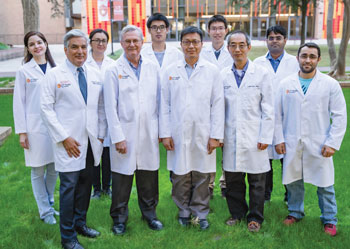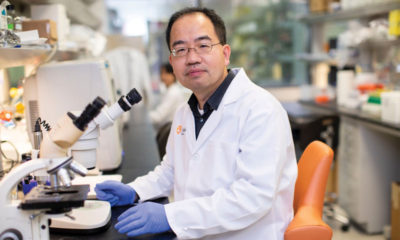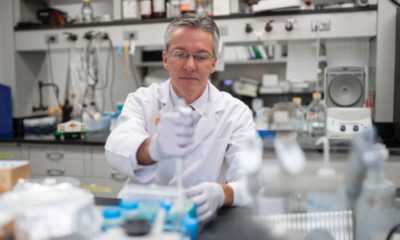Researchers, physicians working together to develop new ways to fight liver cancer

Mays Cancer Center Annual Report
Since 2015, the Clayton Foundation for Research has provided $2.1 million in support for research dedicated to developing state-of-the-art investigations of novel molecular mechanisms that cause hepatocellular carcinoma (HCC), which is the most common liver cancer in adults.

Even before they had such generous funding, transplant surgeons Glenn Halff, M.D., and Francisco Cigarroa, M.D., with LuZhe Sun, Ph.D., and his research team began working together in 2014 to learn why the morbidity and mortality rates of HCC are significantly higher in Hispanics in South Texas than in Hispanics as well as in other ethnic groups in the country.
The South Texas Hispanic population has a two- to four-time higher incidence rate of HCC than the general population in the United States. This important epidemiologic observation was made by Amelie Ramirez, Dr.P.H., who serves as associate director for community outreach and engagement at the Mays Cancer Center.
Dr. Cigarroa, director of the University Transplant Center (a partnership with University Health System), and Dr. Halff, former center director, started providing cancerous liver tumors and adjacent non-tumor samples from the Transplant Center Tumor Bank to Dr. Sun and his team of researchers.
Dr. Cigarroa, the Carlos and Malú Alvarez Distinguished University Chair in Pediatric Transplant Surgery and the Ashbel Smith Professor in Surgery, said the team is creating a biorepository and studying cancer cells in the laboratory, with the goal of developing new strategies for treating HCC in Hispanics from South Texas.
“Developing novel therapeutics for hepatocellular carcinoma has great clinical impact because current therapies remain suboptimal resulting in high mortality for these patients.
Understanding the molecular signatures of Hispanic patients from South Texas suffering from HCC also can perhaps identify a unique mutational driver amenable to targeted therapies,” Dr. Cigarroa said.
Dr. Sun said the research is comprised of three areas and involves a multidisciplinary team including medical and surgical oncologists, radiologists, pathologists, computational biologists and basic scientists.
The first part of this research is establishing resources which include cell lines that are derived from Hispanic patients’ liver cancer tumor tissue and the adjacent non-tumor or normal tissue.
“We also are trying to establish mouse models bearing human liver tumors or make genetically modified mouse models that will spontaneously develop liver cancer,” he said.
The second area is using the tissue samples to find genetic and epigenetic changes, he said.
“The goal is to use bioinformatics and computational biology to analyze these big data sets from the DNA sequencing, RNA sequencing, and proteomics (analysis of whole genome protein levels),” he explained. RNA (ribonucleic acid) acts as a messenger carrying instructions for DNA (deoxyribonucleic acid), which contains the genetic code of organisms.
“We extracted DNA and RNA from the tumor and non-tumor tissues and use next-generation sequencing and our bioinformatics facility which is one of the Mays Cancer Center Shared Resources at UT Health San Antonio.”
The goal is to identify the genes that are mutated as well as the genes that are aberrantly regulated, which means a cell has changed so it is no longer like the normal tissue, he said. “We have recently started using mass spectrometry, which is another shared resource, to try to identify the proteins that are deregulated in the HCC samples.”
This technology is helping the team to identify whether there are unique genes or molecular networks that may contribute to the development and progression of HCC in local patients, he said.
The third area is based on the information gathered from the high-tech analyzation of the samples. “We have been able to identify genes that are mutated or deregulated so we can learn if they contributed to the liver cancer development and progression. We are doing more conventional laboratory research to study these genes’ function.
“Our goal is to see if we can identify potential biomarkers that could be useful for diagnosis, prognosis and treatment of HCC. This information also may be useful for interventions that lead to preventing the disease from even developing,” Dr. Sun said.
At this time, the team has two patents in review related to this research, he said. “We hope they will be approved. We are continuing to analyze the DNA, RNA and protein data.
“We have some leads showing that local Hispanic patients appear to present gene mutations and deregulation that are not the same as profiles from Caucasian patients analyzed by other laboratories.”
Dr. Sun said they are not only trying to find the genes and gene networks that may contribute to the higher incidence of HCC for South Texas Hispanics, but they also want to identify the molecules that can be targeted for prevention, diagnosis, prognosis, and treatment.
“We are working every day to understand the health disparity of this disease,” he added.




